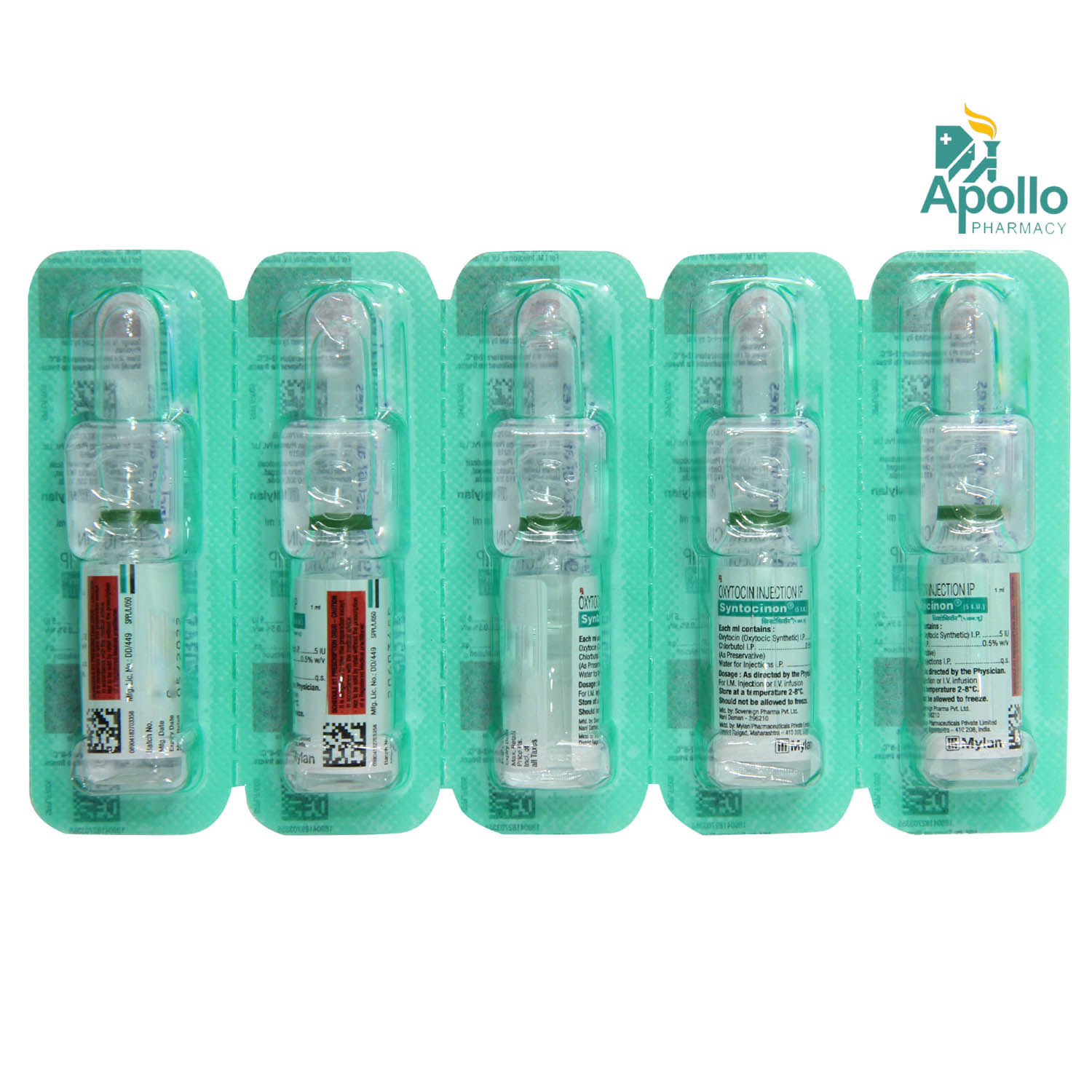Oxytocin
About Oxytocin
Oxytocin belongs to the class of medication called 'oxytocic' or 'uterotonic', primarily used for initiating or improving uterine contraction (antepartum) and producing uterine contraction during the third stage of labour (postpartum). Besides this, it also controls postpartum bleeding or haemorrhage after childbirth. Labour induction stimulates uterine (womb) contractions during pregnancy before labour pain begins to achieve a vaginal birth. It is recommended by the doctor for labour induction for various reasons, especially when there is a concern for a mother's or baby's health.
Oxytocin contains a synthetic female hormone, 'Oxytocin', given in the intravenous (IV) form or intramuscular (IM) form that stimulates uterine muscles and increases the uterus' contractions. It also increases the production of a natural substance called prostaglandins (PGs), increasing contractions and hence inducing labour. As a result, these increased uterine contractions help deliver the child.
Your doctor will give Oxytocin before childbirth or during labour pain. Do not self-administer. The most common side effects of Oxytocin are nausea, vomiting, and headache. Most of these side effects of Oxytocin do not require medical attention and gradually resolve over time. However, if the side effects are persistent, reach out to your doctor.
If you ever had surgery on the uterus, cesarean or premature labour, please inform your doctor before taking Oxytocin to avoid complications. Also, mention all the other medications you are taking to affect how Oxytocin works. If you have been given prostaglandins, Oxytocin should not be given within 6 hours as both medications, if taken together, can increase the contractions. A Oxytocin should not be used for a prolonged time if the contractions do not improve, severe pre-eclamptic toxaemia (high blood pressure, protein in the urine, and swelling), or blood or heart circulation problems.
Uses of Oxytocin
Medicinal Benefits
Oxytocin contains a female hormone primarily used in inducing labour. It plays a major role in childbirth by increasing uterus contractions and inducing labour in pregnant women. In addition to this, it is also used to stop bleeding after delivery and manage a miscarriage in cesarean section. When given in the intravenous form, Oxytocin stimulates uterine muscles and increases the contractions in the uterus. Also, it increases the production of prostaglandins, which further increases contractions and hence induces labour. As a result, these increased uterine contractions help deliver the child.
Directions for Use
Storage
Side Effects of Oxytocin
- Nausea
- Vomiting
- Headache
- Skin rashes
- Fast heartbeat
Drug Warnings
Do not take Oxytocin if you are allergic to Oxytocin or any of its ingredients. Increasing the dose of Oxytocin can be harmful if your womb already has too strong contractions, any obstructions in the pathway that might prevent the delivery or if the baby is not receiving a sufficient oxygen supply. Also, the use of Oxytocin is not advisable if the baby is wrongly positioned in the birth canal, the baby’s head is too large to fit through the pelvis, the placenta lies near the neck of the womb, the placenta separates from the womb before birth, the womb is over-extended and likely to tear (in case you are carrying more than one baby). If you have been given prostaglandins, do not use Oxytocin with 6 hours; if taken together, it can increase the contractions. Oxytocin should not be used for a prolonged time if the contractions do not improve or if you have severe pre-eclamptic toxaemia (high blood pressure, protein in the urine, and swelling) or blood or heart circulation problems. A professional should always administer Oxytocin at a hospital, do not practice self-administration. It should also not be given as a rapid injection into a vein as it might cause hypotension (low blood pressure) or suddenly increased heart rate.
Drug Interactions
Drug-Drug Interactions: Oxytocin interacts with Oxytocin, so it should be used with caution with anaesthetics (sevoflurane, halothane, cyclopropane, desflurane), other medicines used to start labour (prostaglandins), anti-diuretic hormone (vasopressin), a neurotransmitter (dopamine), anti-sickness medication (ondansetron), sympathomimetic agents (epinephrine).
Drug-Food Interactions: Alcoholic beverage intake should be avoided with Oxytocin as it may interact with Oxytocin to produce unpleasant side effects.
Drug-Disease Interactions: Oxytocin should not be given to patients with previous cesarean section, hypertension (high blood pressure), heart problem, cervical cancer, herpes infection, kidney problem if you are more than 40 weeks pregnant or are more than 35 years ago, the pelvis is too small for normal delivery.
Drug-Drug Interactions Checker List:
Safety Advice

Alcohol
unsafeOxytocin should not be taken until prescribed if you are taking alcohol. Keep your doctor informed if you drink alcohol.

Pregnancy
safe if prescribedOxytocin is used to induce contractions in the uterus so if given by the doctor for delivery it is safe.

Breast Feeding
cautionInform your doctor if you are a nursing mother. Your doctor will weigh the benefits and potential risks before prescribing Oxytocin.

Driving
unsafeOxytocin can cause contraction of the uterus and lead to baby birth. So, driving a car may be highly unsafe.

Liver
cautionInform the doctor before receiving the Oxytocin if you have had a Liver impairment/disorder history. Your doctor will prescribe only if the benefits outweigh the risks.

Kidney
cautionInform the doctor before receiving the Oxytocin if you have had a Kidney impairment/disorder history. Your doctor will prescribe only if the benefits outweigh the risks.

Children
cautionOxytocin is not recommended for children below the age of 18 years. The safety and effectiveness of Oxytocin have not been established in children due to limited testing of this drug on children by competent authorities worldwide.
Habit Forming
Diet & Lifestyle Advise
- Long walks can help to relieve stress, keep your body strong, and assist in easy delivery.
- Please take a little Castrol oil as it stimulates prostaglandin, which ripens the cervix and gets labour started.
- For some food like dates, raspberry tea leaves are known to ripen the cervix and get labour started.
- Acupressure also stimulates labour and helps in delivery.
Special Advise
- Oxytocin when given for induction of labour or stimulation of labour, it must be administered only by the intravenous (IV) or intramuscular (IM) route under medical supervision in a hospital.
Patients Concern
Disease/Condition Glossary
Labour induction: When artificially oxytocin is used to stimulate the uterus to contract, it is known as labour induction. There are various reasons for the induction of labour miscarriage, if the pregnancy lasts longer than 42 weeks, a cesarean section or if your water breaks out. Induction of labour is planned in advance, and your doctor will discuss all the advantages and disadvantages with you priorly.
FAQs
Oxytocin when given in the intravenous form, labour induction stimulates uterine muscle contractions in the uterus. Also, it increases the production of prostaglandins, which further increases contractions and hence induces labour. As a result, these increased uterine contractions help deliver the child.
No, giving Oxytocin in the form of a rapid injection into a vein is not recommended as it might cause hypotension (low blood pressure) or suddenly increased heart rate. It should always be given as an intravenous infusion, and the doctor will monitor the speed.
If you have a previous premature delivery, a c-section, or cervical surgery, please inform your doctor before starting Oxytocin. Also, mention a detailed medical history to your doctor to avoid complications.
The most common side effects of Oxytocin include nausea, vomiting, headache, and increased blood pressure. You might also feel increased uterine contractions for some time, but these are manageable under medical supervision.
Oxytocin is given as an injection as an intravenous infusion at a hospital only under strict medical supervision. The dose to be administered will be decided by your doctor, depending upon your current medical situation.




